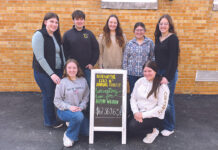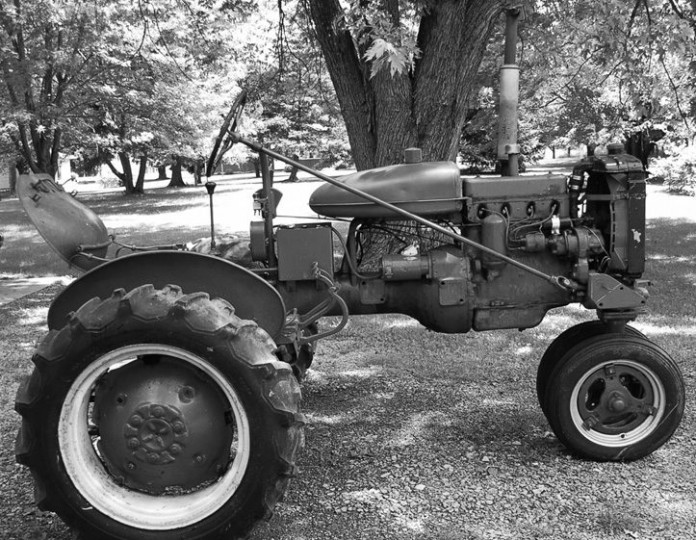For this, my final Rusty Iron column for Farm and Dairy, I thought it might be fun to dig out my first effort which appeared in the May 7, 1992, issue.
It seems a little crude now, so hopefully, the column may have improved a little over the years.
First column
This column is a new venture for me. The Farm and Dairy has been looking for someone to write about old farm machinery and tractors and asked me to give it a try.
Tom Downing thoroughly covers the steam engine field, and Sunny Hull is chiming in with some good stuff on antique tractor pulling.
I’m not an expert on “Rusty Iron,” but I have accumulated some, and I’m interested in the history of the development and evolution of these machines.
The column, then, will be about the antique tractor and implement collecting hobby and farm equipment history, along with a little about the shows I attend.
Growing up. I grew up on a farm in South Beaver Township, in Beaver County, Pa., during the late ’30s, the ’40s, and the early ’50s. As a kid, fascinated by machinery and tractors, I collected a thick scrapbook of tractor and machinery ads and sales literature. It’s a pity that scrapbook wasn’t saved.
My earliest memory of a tractor goes back to about 1936 or 1937.
My father, Sam Moore, and my uncle, Chuck Townsend, were partners in running a three-hundred acre farm belonging to my grandfather, Sherman Moore.
For power, they had a team of horses, named Ted and Polly, and an old, gray, McCormick-Deering 10-20 tractor. I remember riding on the platform, holding on to a fender for dear life, while the old 10-20 jounced and vibrated along on steel lug wheels.
First tractor
About 1939, the 10-20 disappeared and a used, red Farmall F-30 on rubber tires took its place. I was crazy about this tractor and longed to drive it, but my legs were way too short to reach the clutch.
At first, we pulled the old two bottom McCormick-Deering plow we’d used with the 10-20, but later got a three bottom, John Deere, truss frame plow, with rubber tires. The big Farmall and three-bottom plow made quite a rig in our area, since our neighbors all had smaller, one- or two-plow tractors, or none at all.
In the spring of 1941, the horses were sold, and to replace them, a Ford-Ferguson tractor, two-bottom plow, and two-row cultivator, was purchased new. At last, a tractor I was sure I could handle!
Immediately, I started hounding Dad to teach me to drive, and finally, he let me operate the little Ford. I was about eight-years-old and was in heaven.
About three years later, the partners got another new Ford-Ferguson and sold the Farmall, so I never did get to drive it.
Right after this, the partnership was dissolved and the land and equipment divided. Dad ended up with the newer Ford, which we used until he gave up farming in 1953.
Dad moved to Salem, where he managed the Salona Supply Company for many years, and I didn’t have much to do with farming during a career with the Ohio Bell Telephone Co.
Getting older
As I grew older, I developed a hankering to own an old tractor and, about five years ago, I got my first, a 1941 John Deere H. I now have 11 two-cylinder John Deere tractors, ranging in age from 1938 to 1956, in all stages of restoration, or lack thereof.
I’ve also got a nice 1948 Case S tractor and a 1951 Oliver Cletrac crawler tractor that doesn’t run. I have four or five John Deere drag plows, a 1948 John Deere 12A combine that I hope to use this summer to cut wheat and a John Deere Number 5 tractor mower from the late ’40s that is used to cut weeds. I’ve almost completed restoring a 1930 Case-Osborne horse-drawn mower, and have an Emerson-Brantingham-Osborne mower from the 1920s, and an International Harvester Company-Osborne mower from the late teens that I plan to restore.
A future column will explain why all three of these highly competitive companies built Osborne mowers.
Next time, I’ll talk less about me, and more about “Rusty Iron.” If anyone has read this far, and has a comment, suggestion, or question, please write in care of the Farm and Dairy.
Coming to an end. So now, about 27 1/2 years on, it comes to an end, as everything must. I’ve had a lot of fun, met any number of friendly and interesting people, and gained an incredible amount of knowledge about farming through the years — just wish I could remember it all.
For those who don’t know, I’m moving to Salt Lake City, Utah, where my daughter and son-in-law live. So, here’s to new adventures “way out west!”















It has been a pleasure for several years to read your column
thank you very much
Sam,You’ve got no idea just how much I’m ‘gonna miss you! You delivered in such a way that just made Folks not only comfortable,but feel like we were right in it with you! Words just don’t seem to do it justice. You really brought us in and along for the adventure! I can’t Thank You enough! Take Care,My Friend….
Sam, I just found your story on Dr. Booth, my great uncle from Youngstown. He died when I was just 1, but my Aunt Pluma Booth lived while I attended Yoco College and had may nice visits with her. I just had an article about my Uncle Carlos Booth run in an online magazine velocetoday.com The Dr. Booth s 3685, herein Williamsburg, Va. Even though I’ve got a few years on you, I think we have a lot in common. My Uncle Blain Shaffer’s farm was only 100 acres and only horses were ever used. He never drove a car and I always had a horse to ride. another Uncle in Delaware, 0 liked mules better that his tractor or horses. It gettin late and I hope we can talk and meet soon.
Yours truly,
Frank Shaffer
Sam, I’m sure glad to find my note to you got through. I failed to proof read that note very well. I was so excited to read about you able to pull up more of your interesting writings. In another writing I mentioned that I expect to be in Ohio this Spring and would like to set up a meeting. I’m sending on to velocetoday.com (Pete Vack)the editor, with my luck of finding Farm & Dairy If you Google dr booth 1895 car you should find the two articles from last year. I’m looking forward to receiving the magazine.
Sincerely,
Frank Shaffer
To those of you who wrote the above notes, I’m embarrassed to say that I just read them. Thank you for the kind words.
Dear sam Moore,
Today people are wasting so much time with odd computer problems. we have a lot stress in our lives from computers. Do you have an opinion on regarding stress due to technical advance. I don’t mean about the economic effects of life’s stress’. I am referring to our quality of life living in the information age.
people stress over learning to use computers
the results of online life, cyber bulling or screen addiction.
Have you seen competition between manufactures. for example the Apple platform vs the Pc or windows platform. do people have to pay a higher price because of the change in the way America conducts business now compared to the before the 1960-or 50s. Well before the computer age or the information age?
I plan to read histories or dairies of working people to if i can find a clear difference in life.
there is one fact that throws a wrench in the works, that free time, people have more of it now, where in the past it was a matter of work or die, more or less. People have longer life expectancy now. I wonder though is it a life with qualities more less the same in the different generations?
Thanks for your thoughts and time
Paul Nason Wisconsin
ps
I guess I will have to add that of working people. Not the wealthy sort of upper class, lets forget about those guys.